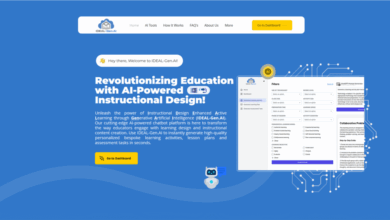5 Benefits of Technology in the Classroom
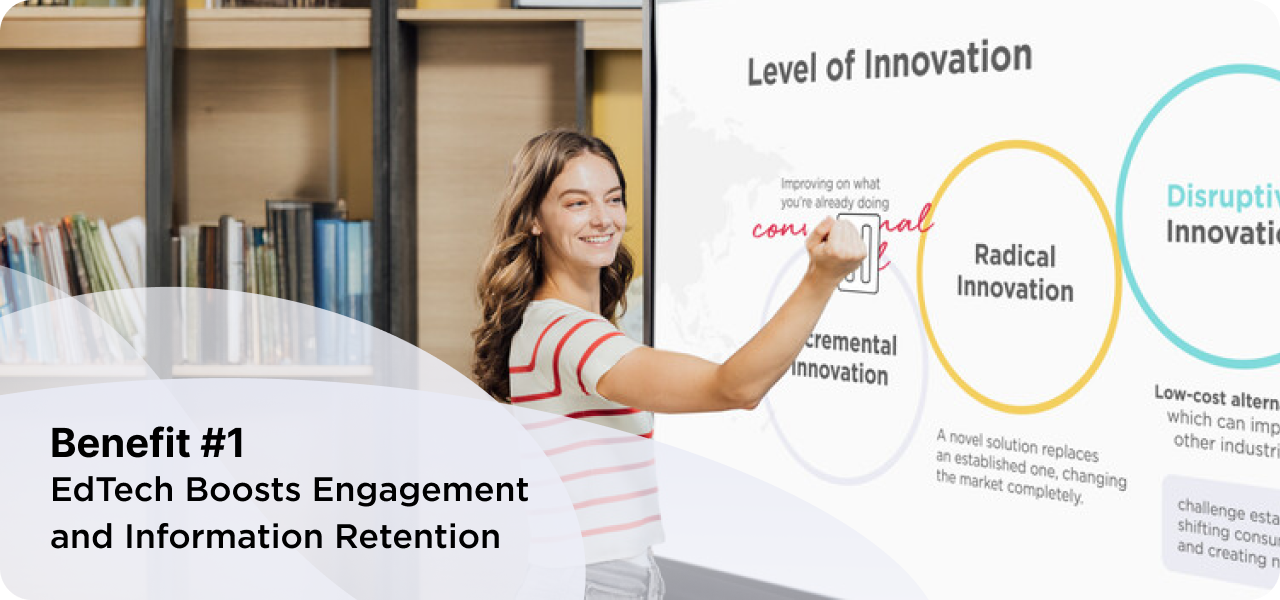
5 Benefits of Technology in the Classroom
There are many benefits of technology in the classroom, so we’ve picked five of the most significant for this handy list. From boosting student engagement to creating more inclusive learning environments, the right EdTech tools can support a wide range of learning outcomes. Plus, staying up to date with the latest tech helps prepare students for the challenges of tomorrow.
Read on for the top 5 advantages of technology in the classroom, or visit ViewSonic Education Solutions for smart tools tailored to your school’s goals.
It’s no exaggeration to say that technology has transformed the classroom and brought enormous benefits. In a fairly short time, amazing innovations like iPads, laptops, and smartphones have opened up a new world of information for students of all ages. Adapting to this exciting new reality can be challenging for both teachers and students. But for those who embrace it, the advantages are virtually limitless.
Digital technologies are indispensable in the educational process.
Himendra Balalle, National Institute of Business Management
Let’s jump into the biggest advantages of using technology in the classroom, starting with one that every teacher values—getting students truly motivated to learn.
Benefit #1: EdTech Boosts Engagement and Information Retention

We’ve all had that moment in class: a student lost in thought, staring out the window or drumming their fingers, clearly checked out. Disengagement like this is more common than we’d like. In fact, one in four pupils in England report feeling disconnected when they transition to secondary school. And when students tune out, learning becomes an uphill climb..
Now flip the script. Hand that same student a tablet with an interactive lesson or let them dive into a digital quiz, and suddenly they’re leaning in, not zoning out. A six-year study from Rochester Institute of Technology actually found that 90% of students felt tech tools helped them better understand and remember what they were taught.
That’s because interactive learning does more than engage—it activates. A systematic review on technology-based student engagement highlights how tech-driven activities inspire motivation, focus, and energy by encouraging active participation.
And the benefits go deeper. The same review found that active learning frameworks increase engagement and collaboration while also enhancing the overall learning experience, driving stronger academic outcomes. If you’re curious about bringing this approach to life, check out our article on how EdTech and smart classroom design can help create active learning spaces.
So whether you’re in a fifth-grade classroom or a college lecture hall, using technology to support active learning isn’t just effective—it’s essential for helping students stay engaged and truly retain what they learn.
Benefit #2: EdTech Accommodates Multiple Learning Styles
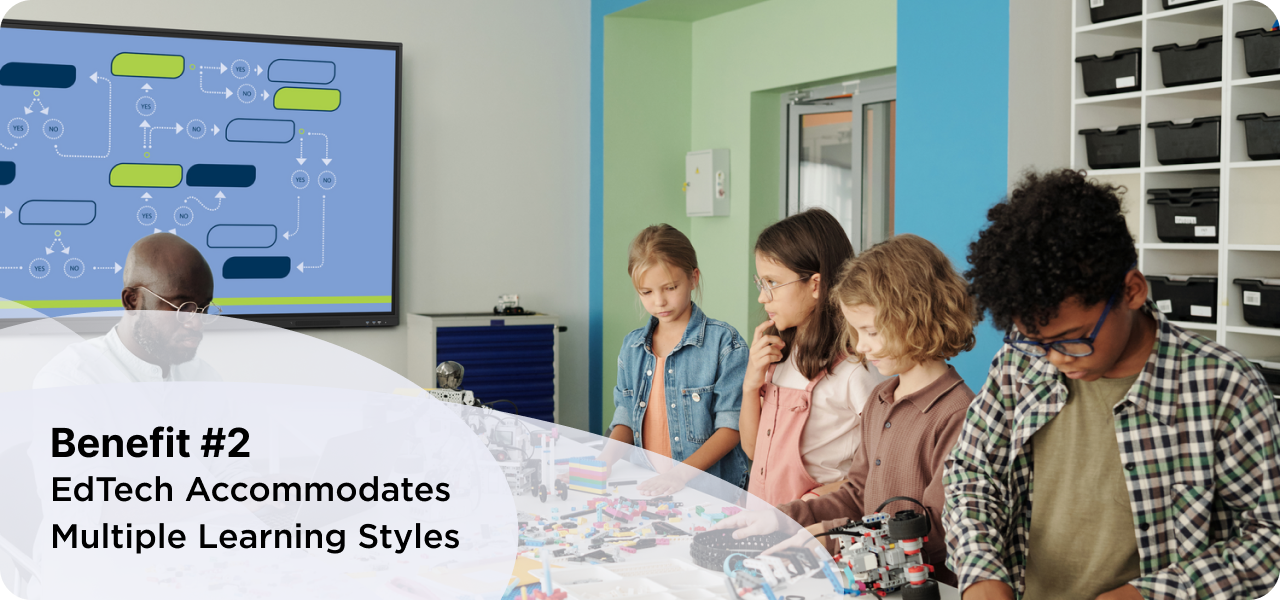
Ask any teacher: No two students absorb information in the same way. One might light up during a podcast, while another needs to see it mapped out visually. Some students can’t sit still—they need to do to learn.
These individual differences are exactly why personalized learning matters. And today’s digital tools are making it easier than ever. A recent literature review backs this up, emphasizing how educational technology improves accessibility while helping tailor the experience to meet each student’s unique learning needs.
Personalized learning (PL) has emerged as a promising instructional practice to address the diverse needs of learners in recent years.
Bernacki, M.L., Greene, M.J. & Lobczowski, N.G., A Systematic Review of Research on Personalized Learning: Personalized by Whom, to What, How, and for What Purpose(s)?.
This is where learning styles come in. By understanding how students learn best—and pairing those insights with the right tech—we can create classrooms that are more inclusive, more engaging, and more effective. If you’re ready to explore the full range of learning preferences, we’ve got a deep dive into all eight learning styles.
But for now, here’s a closer look at three of the most common, and how classroom technology can help support each one:
For Auditory Learners
Auditory learners thrive when information is delivered through sound. For them, tools like recorded lessons, audiobooks, and podcasts aren’t just helpful—they’re essential.
One standout strategy? Podcasting. It allows students to review content at their own pace while offering a creative outlet. By scripting, recording, and sharing audio, they not only reinforce key concepts but also sharpen skills like writing, storytelling, and public speaking—all through a format that suits them best.
For Visual Learners
Also known as spatial learners, visual learners process information through sight. They tend to read quickly, notice details, and benefit from diagrams, color coding, and visual storytelling.
Interactive displays are especially useful here. A mind map or flowchart can help them see the “big picture,” while digital whiteboarding tools that let students move shapes, draw connections, and explore layered content make learning more intuitive and memorable.
For Kinesthetic (Tactile) Learners
Kinesthetic learners need to move, touch, and interact to learn effectively. Traditional lectures often don’t stick with them, but EdTech can help bring hands-on learning into the digital age.
With touchscreen displays and interactive tablets, these learners don’t just watch—they dive in. Whether they’re dragging and dropping their way through a math puzzle or tapping their way through a virtual biology lab, that hands-on interaction helps turn learning into something they can feel, not just memorize.
Simply put, accommodating multiple learning styles allows education to be delivered in a more personalized way. And that’s a win for every student.
Benefit #3: EdTech Encourages Collaboration
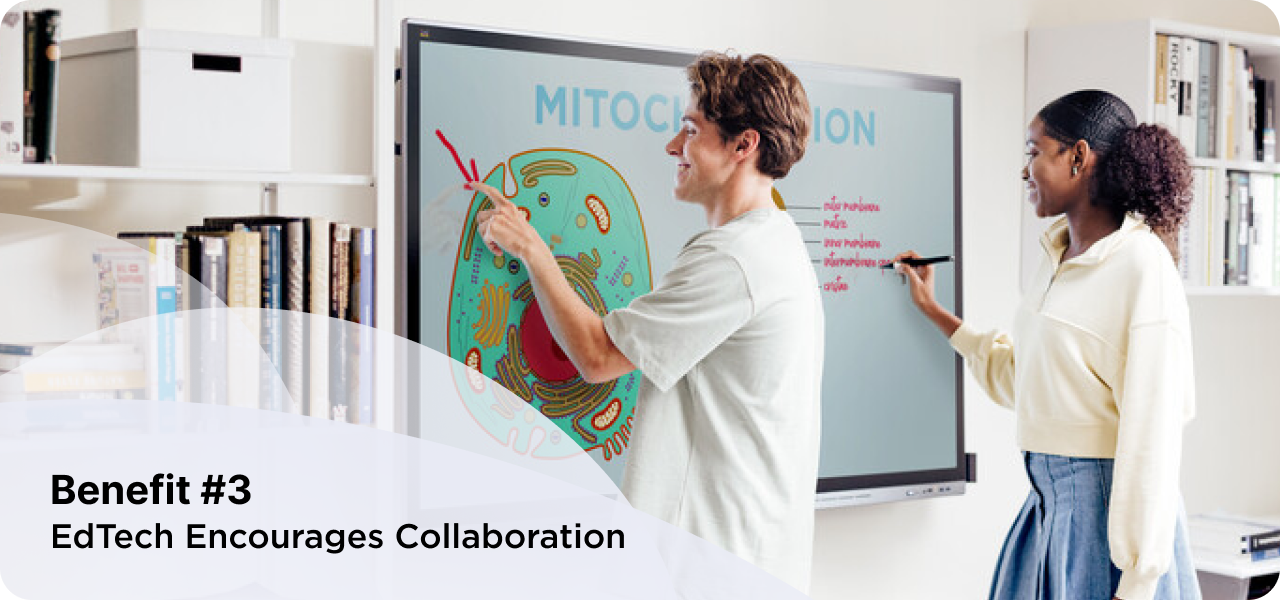
Collaboration has always been part of great learning. In fact, the Education Endowment Foundation reports that collaborative learning strategies can accelerate student progress by an average of five months—a serious boost for any classroom. And it’s not just students who benefit. Research by the UK Department for Education shows that when schools work together on shared research and development, teachers develop fresh perspectives, boost their motivation, and build stronger leadership skills.
Add technology to the mix, and collaboration becomes even more impactful. platforms like myViewBoard come in, turning classroom whiteboards into shared spaces where everyone can contribute, brainstorm, and present together. In remote or hybrid settings, TeamOne makes that same kind of teamwork possible on a digital canvas. And with something like ePals, students can take things global and connect with peers in other countries. Suddenly, a simple writing exercise becomes an exciting chance to swap stories with someone across the globe.
On top of that, these tools give teachers real-time visibility into student participation, making it easier to guide discussions, encourage engagement, and keep projects on track. And because students already live in a world of sharing, creating, and collaborating online, bringing those instincts into the classroom feels natural. The result? Faster idea flow, smoother group projects, and teamwork that feels less like a task and more like a creative adventure.
Benefit #4: EdTech Provides Instant Feedback for Teachers
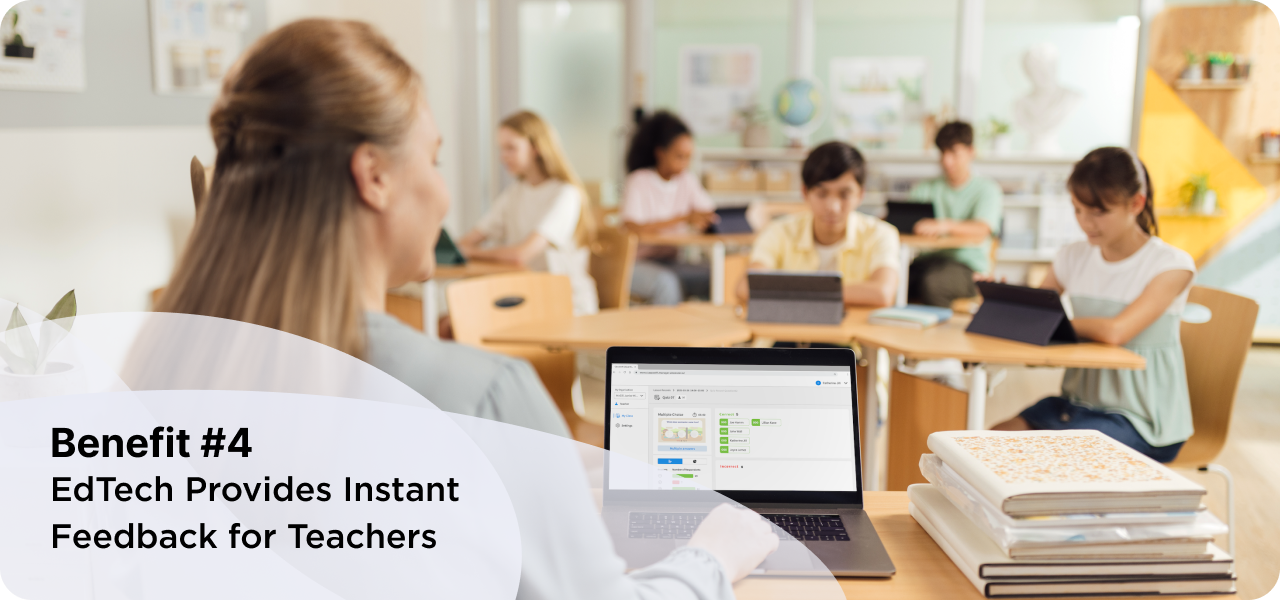
Instead of waiting for the next class or collecting stacks of paper, they can send quick comments, voice notes, or even short videos to guide students in the moment. Students, in turn, can submit work, ask questions, or respond to polls directly from their devices, keeping learning on track without disrupting the flow of the lesson.
Some tools, like ClassSwift, streamline this even further. As students submit their answers through their own devices, the platform automatically grades their responses in real time. This gives teachers immediate insight into student understanding while saving valuable time on manual marking.
And this isn’t just about saving time. There’s solid research backing the value of rapid, personalized feedback. Studies show that when students receive immediate responses to their work, it has a greater impact than delayed feedback, helping them correct misunderstandings quickly and build deeper expertise.
Because everything is stored digitally, it’s easy to revisit feedback later—whether to check progress, plan next steps, or offer targeted support. It’s a simple shift that helps make feedback not just faster, but more meaningful and integrated into everyday learning.
Benefit #5: EdTech Prepares Students for the Future
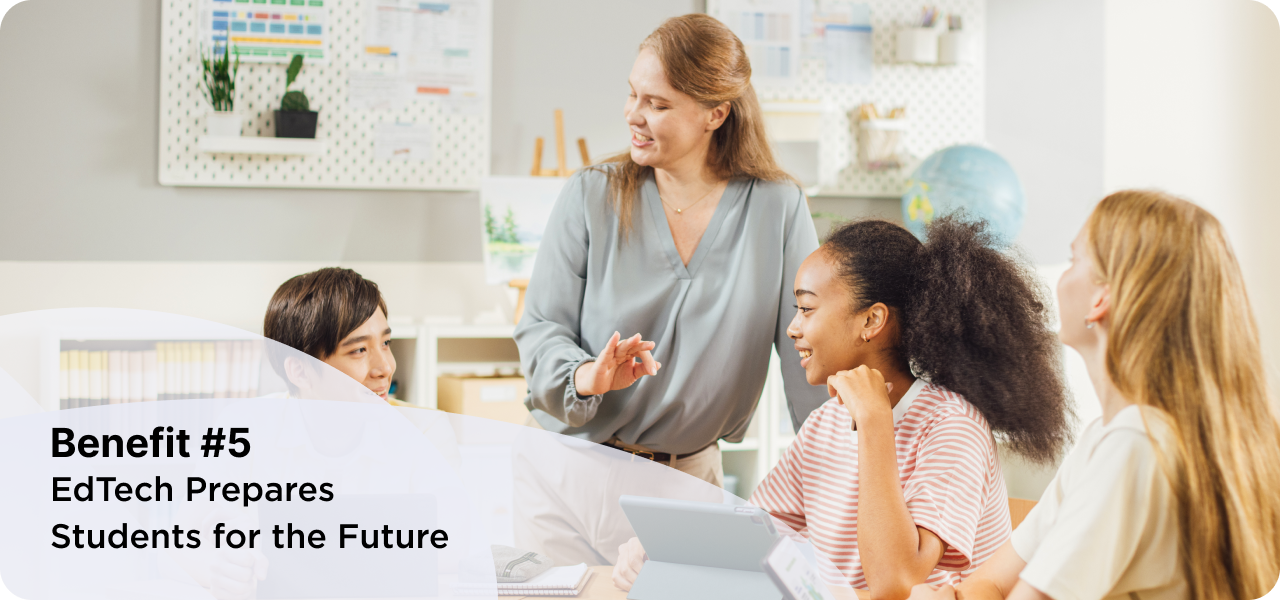
At its core, education is about helping students get ready for what’s next—college, a career, or just navigating life in an always-online world. And let’s be real: the world they’re walking into moves fast, and tech is at the center of it all. For schools, this isn’t about chasing shiny new gadgets. It’s about giving students a fair shot in a future that won’t wait.
When students get hands-on with technology—collaborating on digital platforms, turning in work online, or learning how to use AI the right way—they’re not just building tech skills. They’re developing virtual intelligence and AI fluency, two of the World Economic Forum‘s top must-haves for the future of work. It’s a glimpse of what’s ahead: lecture halls, design studios, startup offices, or remote roles that don’t even exist yet.
Virtual intelligence – the ability to work effectively across digitally mediated environments, including full-time office environments. This skill set has become indispensable for anyone collaborating with clients, colleagues, or partners across time zones, geographies and platforms.
Ronit Avni, Founder & Chief Executive Officer of Localized
The future’s not hitting pause, so when we equip students with the skills they need, we empower them to walk into the world ready, confident, and one step ahead.
Final Thoughts
Technology in the classroom is no longer just a nice-to-have. It helps boost engagement, supports different learning needs, encourages collaboration, and makes feedback faster and more meaningful. Most importantly, it builds the skills students need to succeed beyond school, whether that’s in higher education, the workplace, or everyday life.
Of course, none of this happens without the right tools. The best EdTech solutions are flexible enough to adapt to your teaching style and your students’ needs. Whether you’re already comfortable with tech or just starting to explore what’s possible, now’s the time to lean in—the future isn’t slowing down—and your students are looking to you to help them keep up.
Curious where to start? Take a look at our full Technology in the Classroom guide, or explore ViewSonic Education Solutions for EdTech tailored to your school’s needs.

The post 5 Benefits of Technology in the Classroom appeared first on ViewSonic Library.





